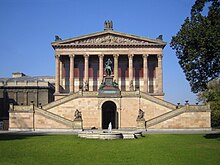Nebra sandstone

The Nebra sandstone was mined in a deposit near Nebra on the Unstrut in the west of the Burgenland district in Saxony-Anhalt. This sandstone deposit was created in the red sandstone .
history
In 1182 the mining of Nebra sandstone on the right and left of the Unstrut was demonstrably started. Since the Unstrut made it possible to ship the natural stones , this sandstone was not only built regionally. The quarry was closed in 1962. Due to great demand, a quarry was reopened in 1996, which produces salmon-colored sandstone.
Rock description and mineralogy
This sandstone is reddish to dark red, yellow and white, white-gray and gray. In the deeper layers of the deposits these sandstones are dark reddish and in the higher layers the light red predominate. It is fine to medium-grained, rarely also coarse-grained and it is clayey. It also carries small amounts of feldspar and mica and sometimes small amounts of pyrite . The strength and weather resistance show significant differences. Its water absorption is high due to its porosity.
use
Nebraer sandstone was for solid buildings, factory use and bricks, door and window frames, tiles, stairs and flooring. A distinction is made between two types according to their color, the salmon-colored Nebra salmon sandstone , which is in particularly high demand today, and the red Nebra sandstone .
It was used on the old Berlin Reichstag, on the Berlin and Hamburg stock exchanges, on the facade of the Alte Nationalgalerie at the Technical University as well as on the Rotes Rathaus in Berlin, the Belvedere Palace in Weimar and the Brandenburg Gate . Other stone works made from Nebra sandstone are the distance column in Brehna (1730), St. George's Church in Nebra and the church in Gehofen .
See also
literature
- W. Dienemann and O. Burre: The usable rocks of Germany and their deposits with the exception of coal, ores and salts, Enke-Verlag, Stuttgart 1929
